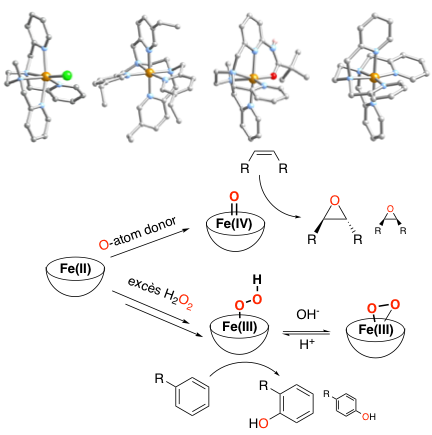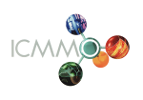Chimie Inorganique
Complexes du fer, catalyseurs d'oxydation bioinspirés
Frédéric Banse (Prof), Jean-Noël Rebilly (CR), Katell Sénéchal-David (MCF)
Ingénieure d'étude : Flora Lefebvre
Doctorante : Amanda Robinson
En synthèse chimique, la conversion de molécules organiques en produits oxydés à plus haute valeur ajoutée est souvent effectuée dans des conditions stœchiométriques et sévères (hautes température et pression, oxydants forts générant des sous-produits nocifs ou toxiques). La recherche de solutions alternatives utilisant le dioxygène moléculaire (oxydant très bon marché, abondant et bénin d'un point de vue environnemental) est donc un enjeu évident. Cependant, à cause de son état fondamental triplet de spin (S=1), la réaction de O2 avec des espèces diamagnétiques est infiniment lente. Son activation est donc nécessaire afin de franchir la barrière cinétique.
De manière intéressante, certaines métalloenzymes (monooxygénases, dioxygénases, hydroxylases) sont capables d'utiliser O2 pour catalyser l'oxydation chemo- et régiosélective de petites molécules organiques dans des conditions douces. Pour cela, elles réalisent "l'activation réductrice du dioxygène" dans leur site actif qui contient un ion métallique biodisponible et abondant (Fe, Mn, Cu…) : l'activation de O2 nécessite sa réduction partielle et contrôlée. La modélisation de ces catalyseurs naturels par des systèmes synthétiques plus simples paraît donc pertinente tant d'un point de vue fondamental (détermination des mécanismes réactionnels) que pratique (valorisation de matière première abondante).
Avec des systèmes synthétiques peu coûteux (complexes de FeII non hémiques) et en présence d'oxydants chimiques, il est possible de générer des intermédiaires réactionnels Fe-peroxo, Fe-oxo de haute valence, capables d'oxyder de petites molécules organiques. Ces espèces sont analogues à celles identifiées dans le cycle catalytique des enzymes. Nos objectifs sont :

1/ de comprendre la réactivité intrinsèque de ces espèces afin de les exploiter en catalyse (Isolement et étude des intermédiaires réactionnels) ;
2/ de reproduire plus fidèlement la réactivité des systèmes naturels en utilisant des petites molécules renouvelables (O2, H2O) plutôt que des oxydants chimiques (Activation de petites molécules) ;
3/ d'améliorer la réactivité de ces catalyseurs en jouant sur leur seconde sphère de coordination via des effets supramoléculaires (Insertion des catalyseurs dans des systèmes supramoléculaires et effets de seconde sphère).
Thèses
En cours
Amanda Robinson — Nouveaux complexes de fer avec une seconde sphère de coordination non-innocente pour la catalyse d'oxydation bio-inspirée
Directeur de thèse : Frédéric Banse ; Co-encadrant : Jean-Noël Rebilly (Démarrée en octobre 2018)
Soutenues
Antoine Bohn — Activation réductrice de O2 par des complexes moléculaires à base de fer : Vers des réactions d'oxydation plus vertueuses (2018)
Directeur de thèse : Frédéric Banse ; Co-encadrante : Katell Sénéchal-David
Charlotte Buron — Développement de nouveaux catalyseurs d'oxydation bioinspirés: Greffage de complexes de fer(II) non hémiques sur électrodes d'or ou dans la β-lactoglobuline (2015)
Directeur de thèse : Frédéric Banse ; Co-encadrante : Katell Sénéchal-David
Nathalie Segaud — Etude de l'activation réductrice du dioxygène par un complexe de FeII et nouveaux complexes hétérodinucléraires : Contributions pour le développement de catalyseurs d'oxydation bioinspirés (2013)
Directeur de thèse : Frédéric Banse ; Co-encadrante : Katell Sénéchal-David
Dernières publications (2016 - Auj.)
Influence of a 2nd Sphere Hydrogen-Bond Donor on the Reactivity of Non-heme Fe(II) Complexes in Alkane, Alkene and Aromatic Oxidation with H2O2. A. L. Robinson, E. Bannerman, M. Di Berto Mancini, W. R. Browne, R. Guillot, C. Herrero, T. Inceoglu, H. Maisonneuve, F. Banse, J.-N. Rebilly, Chemistry – A European Journal, 2025, n/a, e202404668
Electrochemical approach of the reductive activation of O2 by a nonheme FeII complex. Some clues for the development of catalytic oxidations. A. Bohn, A. L. Robinson, K. Sénéchal-David, C. Herrero, F. Kanoufi, E. Anxolabéhère-Mallart, F. Banse, Dalton Trans., 2024, 53, 15491-15500
Modulation of intramolecular Fe oxidation with distance and driving force in Ru–Fe photocatalysts. C. Herrero, F. Banse, W. Leibl, A. Quaranta, New J. Chem., 2024, 48, 17027-17037
Assessment of new hydrogen peroxide activators in water and comparison of their active species toward contaminants of emerging concern. G. Farinelli, J.-N. Rebilly, F. Banse, M. Cretin, D. Quemener, Scientific Reports, 2024, 14, 9301
Significant effect of 2nd sphere interactions on the reductive activation of O2 by non-heme iron(II) complexes. Application to the electroassisted oxidation of thioanisole. A. L. Robinson, E. Bannermann, R. Guillot, C. Herrero, K. Sénéchal-David, E. Rivière, F. Banse, J.-N. Rebilly, European Journal of Inorganic Chemistry, 2024, 27, e202300694
Beneficial Effect of Acetic Acid on the Formation of FeIII(OOH) Species and on the Catalytic Activity of Bioinspired Nonheme FeII Complexes. R. Bercy, J.-N. Rebilly, C. Herrero, R. Guillot, H. Maisonneuve, F. Banse, European Journal of Inorganic Chemistry, 2023, 26, e202300236
Disproportionation of H2O2 to Dioxygen on a Nonheme Iron Center. A Computational Study. H. P. H. Wong, F. Banse, S. P. De Visser, ChemCatChem, 2023, n/a, e202300957
Iron ions embedded in hexagonal mesoporous silica via a simple method: implementation in mild oxidation catalysis. R. Guemati, J.-N. Rebilly, G. Fornasieri, D. Dragoe, S. Biswas, F. Banse, A. Bleuzen, ChemistrySelect, 2023, 8, e202302150
Revitalizing Inert Materials: Grafting Self‐Oscillating, Stimuli‐Responsive Organometallic Polymers for Pulsating Systems. J. Pirkin‐benameur, V. Bouad, F. Lefèbvre, D. Bouyer, K. Sénéchal‐david, J.-N. Rebilly, F. Banse, D. Fournier, P. Woisel, J. Lyskawa, Advanced Materials Interfaces, 2023, 2300346
Catalytic oxidation properties of an acid-resistant cross-bridged cyclen Fe(ii) complex. Influence of the rigid donor backbone and protonation on the reactivity. J.-N. Rebilly, C. Herrero, K. Sénéchal-David, R. Guillot, F. Banse, Dalton Trans., 2023, 52, 9017-9025
Heterolytic O− O bond cleavage upon single electron transfer to a nonheme Fe (III)− OOH complex. A. Bohn, K. Sénéchal‐david, J.-N. Rebilly, C. Herrero, W. Leibl, E. Anxolabéhère‐mallart, F. Banse, Chemistry–A European Journal, 2022, 28, e202201600
Photocatalytic generation of a non-heme Fe(iii)-hydroperoxo species with O2 in water for the oxygen atom transfer reaction. E. Pugliese, N. T. Vo, A. Boussac, F. Banse, Y. Mekmouche, J. Simaan, T. Tron, P. Gotico, M. Sircoglou, Z. Halime, W. Leibl, A. Aukauloo, Chem. Sci., 2022, 13, 12332-12339
A tale of two complexes: electro-assisted oxidation of thioanisole by a “O2 activator / oxidizing species” tandem system of non-heme iron complexes. A. L. Robinson, J.-N. Rebilly, R. Guillot, C. Herrero, H. Maisonneuve, F. Banse, Chemistry – A European Journal, 2022, 28, e202200217
Second-sphere effects on H2O2 activation by non-heme FeII complexes: role of a phenol group in the [H2O2]-dependent accumulation of FeIVO vs. FeIIIOOH. J.-N. Rebilly, C. Herrero, K. Sénéchal-David, R. Guillot, T. Inceoglu, H. Maisonneuve, F. Banse, Chem. Sci., 2021, 12, 15691-15699
Tracking light-induced electron transfer toward O2 in a hybrid photoredox-laccase system. R. Farran, Y. Mekmouche, N. T. Vo, C. Herrero, A. Quaranta, M. Sircoglou, F. Banse, P. Rousselot-Pailley, A. J. Simaan, A. Aukauloo, T. Tron, W. Leibl, iScience, 2021, 24, 102378
Modulating alkene reactivity from oxygenation to halogenation via electrochemical O2 activation by Mn porphyrin. N. Kostopoulos, F. Banse, C. Fave, E. Anxolabéhère-Mallart, Chem. Commun., 2021, 57, 1198-1201
Sequential installation of Fe(ii) complexes in MOFs: towards the design of solvatochromic porous solids. F. Moreau, J. Marrot, F. Banse, C. Serre, A. Tissot, J. Mater. Chem. C, 2020, 8, 16826-16833
Directing the solid-state photochromic and luminescent behaviors of spiromolecules with Dawson and Anderson polyoxometalate units. H. Dridi, A. Boulmier, P. Bolle, A. Dolbecq, J.-N. Rebilly, F. Banse, L. Ruhlmann, H. Serier-Brault, R. Dessapt, P. Mialane, O. Oms, J. Mater. Chem. C, 2020, 8, 637-649
Non-Symmetrical Sterically Challenged Phenanthroline Ligands and Their Homoleptic Copper(I) Complexes with Improved Excited-State Properties. L. Gimeno, E. Blart, J.-N. Rebilly, M. Coupeau, M. Allain, T. Roisnel, A. Quarré De Verneuil, C. Gourlaouen, C. Daniel, Y. Pellegrin, Chemistry – A European Journal, 2020, 26, 11887-11899
Playing with Magnetic Anisotropy in Hexacoordinated Mononuclear Ni(II) Complexes, An Interplay Between Symmetry and Geometry. N. Suaud, G. Rogez, J.-N. Rebilly, M.-A. Bouammali, N. Guihéry, A.-L. Barra, T. Mallah, Applied Magnetic Resonance, 2020, 59, 13341-13346
FeIII and FeII Phosphasalen Complexes: Synthesis, Characterization, and Catalytic Application for 2-Naphtol Oxidative Coupling. E. Oheix, C. Herrero, J. Moutet, J.-N. Rebilly, M. Cordier, R. Guillot, S. Bourcier, F. Banse, K. Sénéchal-David, A. Auffrant, Chemistry – A European Journal, 2020, 26, 13634-13643
Hydroxylation of Aromatics by H2O2 Catalyzed by Mononuclear Non-heme Iron Complexes: Role of Triazole Hemilability in Substrate-Induced Bifurcation of the H2O2 Activation Mechanism. J.-N. Rebilly, W. Zhang, C. Herrero, H. Dridi, K. Sénéchal-David, R. Guillot, F. Banse, Chemistry – A European Journal, 2020, 26, 659-668
Base-controlled mechanistic divergence between iron(iv)-oxo and iron(iii)-hydroperoxo in the H2O2 activation by a nonheme iron(ii) complex. A. Bohn, C. Chinaux-Chaix, K. Cheaib, R. Guillot, C. Herrero, K. Sénéchal-David, J.-N. Rebilly, F. Banse, Dalton Trans., 2019, 48, 17045-17051
A Reversible Electron Relay to Exclude Sacrificial Electron Donors in the Photocatalytic Oxygen Atom Transfer Reaction with O2 in Water. N. T. Vo, Y. Mekmouche, T. Tron, R. Guillot, F. Banse, Z. Halime, M. Sircoglou, W. Leibl, A. Aukauloo, Angewandte Chemie International Edition, 2019, 58, 16023-16027
Non-heme FeII diastereomeric complexes bearing a hexadentate ligand : unexpected consequences on the spin state and oxidation catalytic properties. K. Sénéchal-David, C. Buron, N. Ségaud, J.-N. Rebilly, A. Dos Santos, J. Farjon, R. Guillot, C. Herrero, T. Inceoglu, F. Banse, Chem. Eur. J., 2019, 25, 12405 – 12411
Bioinspired molecular catalysts for homogenous electrochemical activation of dioxygen. E. Anxolabéhère-Mallart, F. Banse, Current Opinion in Electrochemistry, 2019, 15, 118-124
Selective Formation of an FeIVO or an FeIIIOOH Intermediate From Iron(II) and H2O2 : Controlled Heterolytic versus Homolytic Oxygen-Oxygen Bond Cleavage by the Second Coordination Sphere. K. Cheaib, M. Q. E. Mubarak, K. Sénéchal-David, C. Herrero, R. Guillot, M. Clémancey, J.-M. Latour, S. D. Visser, J.-P. Mahy, F. Banse, F. Avenier, Angew. Chem. Int. Ed., 2019, 58, 854-858
Chemoselective guest-triggered shaping of a polynuclear CuII calix[6]complex into a molecular host. S. Richard, G. Le Duc, N. Le Poul, Y. Le Mest, O. Reinaud, J.-N. Rebilly, Dalton Trans., 2017, 46, 15249-15256
Imidazolidine Ring Cleavage upon Complexation with First Row Transition Metals. K. Cheaib, C. Herrero, R. Guillot, F. Banse, J.-P. Mahy, F. Avenier, Eur. J. Inorg. Chem., 2017, 3884-3891
Synthesis and characterization of FeII complexes with a BPMEN type ligand bearing π-accepting nitro groups. A. Bohn, K. Sénéchal-David, J. Vanoutryve, R. Guillot, E. Rivière, F. Banse, European Journal of Inorganic Chemistry, 2017, 3057-3063
Mimicking the Regulation Step of Fe-Monooxygenases: Allosteric Modulation of FeIV-Oxo Formation by Guest Binding in a Dinuclear ZnII–FeII Calix[6]arene-Based Funnel Complex. N. Ségaud, C. De thomasson, C. Daverat, K. Sénéchal-David, A. Dos Santos, V. Steinmetz, P. Maître, J.-N. Rebilly, F. Banse, O. Reinaud, Chemistry – A European Journal, 2017, 23, 2894-2906
Characterization and Subsequent Reactivity of an Fe-Peroxo Porphyrin Generated by Electrochemical Reductive Activation of O2. R. Oliveira, W. Zouari, C. Herrero, F. Banse, B. Schöllhorn, C. Fave, E. Anxolabéhère-Mallart, Inorg. Chem., 2016, 55, 12204-12210
Photoassisted Oxidation of Sulfides Catalyzed by Artificial Metalloenzymes Using Water as an Oxygen Source. C. Herrero, N. Nguyen-Thi, F. Hammerer, F. Banse, D. Gagné, N. Doucet, J.-P. Mahy, R. Ricoux, Catalysts, 2016, 6, 202
Self-assembled monolayer formation of a (N5)Fe(ii) complex on gold electrodes: electrochemical properties and coordination chemistry on a surface. C. Buron, S. Groni, N. Segaud, S. Mazerat, D. Dragoe, C. Fave, K. Senechal-David, B. Schollhorn, F. Banse, Dalton Trans., 2016, 45, 19053-19061
Arene activation by a nonheme iron(III)–hydroperoxo complex: pathways leading to phenol and ketone products. A. S. Faponle, F. Banse, S. P. De Visser, JBIC Journal of Biological Inorganic Chemistry, 2016, 21, 453-462
Oxidation catalysis via visible-light water activation of a [Ru(bpy)3]2+ chromophore BSA-metallocorrole couple. C. Herrero, A. Quaranta, R. Ricoux, A. Trehoux, A. Mahammed, Z. Gross, F. Banse, J.-P. Mahy, Dalton Trans., 2016, 45, 706-710
Dernière mise à jour le 28.02.2022

